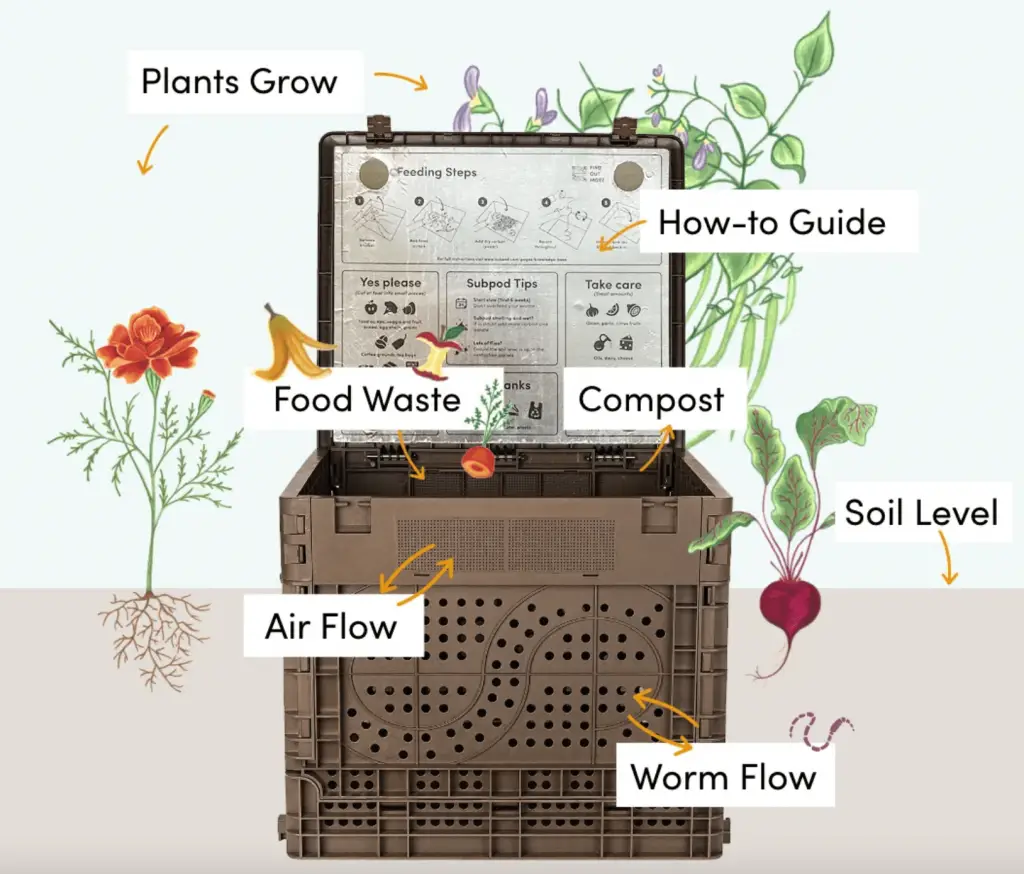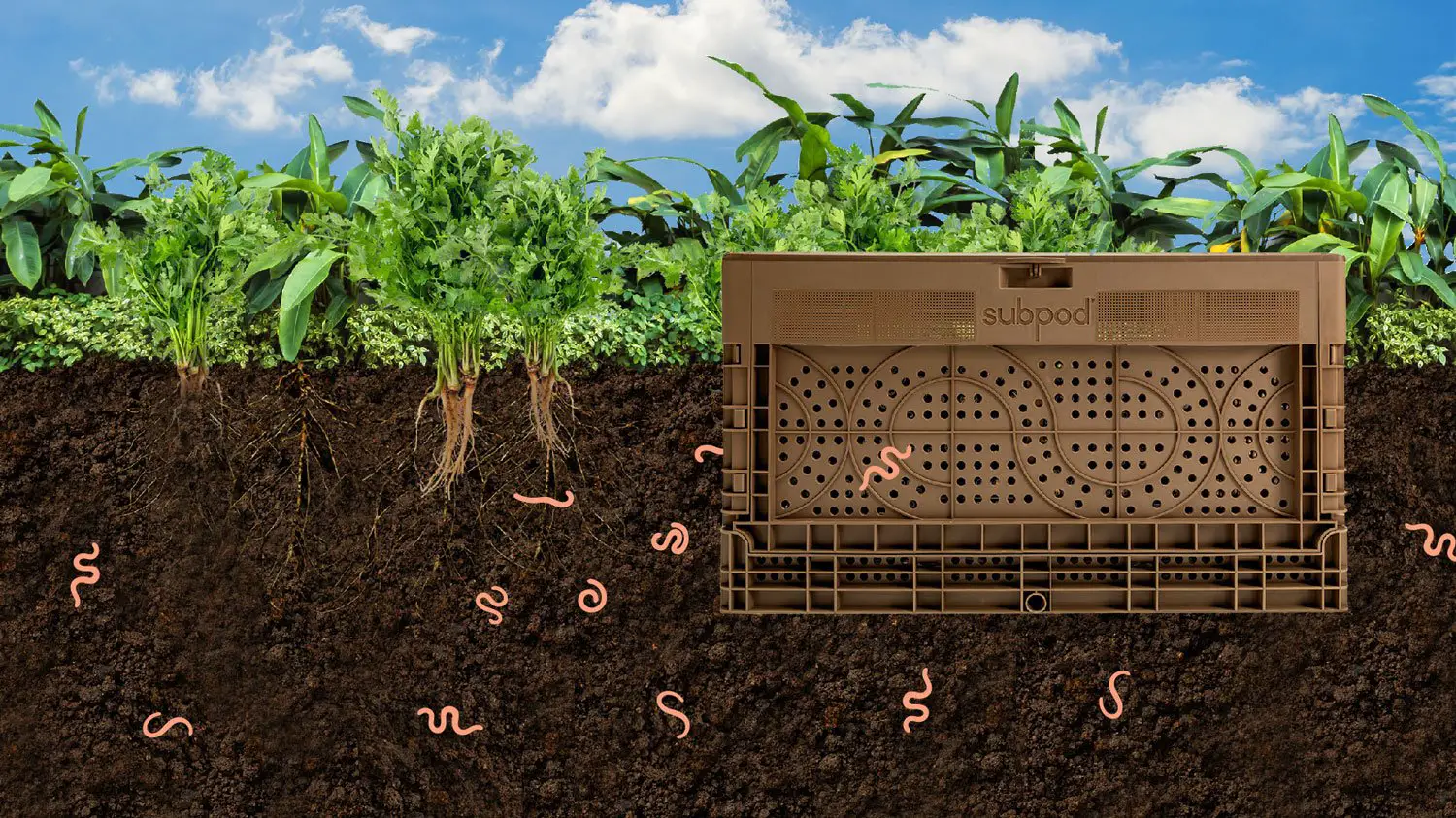Subpod is an in-ground compost system and worm farm for first-time users. Subpod composting is a great way to reduce your environmental impact by recycling organic waste. It is a simple, stress-free, efficient, and affordable system that anyone can use.
Table of Contents
What is a Subpod Compost System?
A subpod compost system is a composting bin designed to make it easy to create and maintain a compost pile. It is an in-ground compost system and worm farm for first-time users.
A subpod compost system can also be defined as a composting system that uses earthworms to degrade organic matter.
The subpod consists of two main components:
- A base unit that holds the compostable material.
- A lid that helps to control moisture and temperature levels.
The base unit is typically made from recycled plastic, rigid polypropylene, or wood, and it has a series of holes that allow air to circulate. The lid is usually made from breathable fabric, which helps keep the compost pile moist while allowing excess heat to escape.
To use a subpod compost system, add your kitchen scraps (for instance, veggies) and other organic material to the base unit and then cover it with the lid. The subpod will aerate the material and keep it moist, and you can add new material to the bin as needed.
Once the bin is full, you can remove the bottom layer of compost and use it in your raised garden bed or lawn.
Subpod Structure
The subpod compost system comprises three parts:
- The upper chamber: The upper chamber is used to store food scraps and other organic matter.
- The earthworm chamber: The earthworm chamber is where the compost worms live and compost the organic matter.
- The subsoil: The subsoil stores leachate, a liquid that drains from the compost.
The subpod compost system can be used to compost food scraps, paper, leaves, and other organic matter. The earthworms and microbes consume the organic matter and convert it into nutrient-rich compost.
The leachate from the compost can be used to water plants or can be recycled back into the subpod compost system.

How Does it Work?
The subpod compost system is a three-chamber composter that uses gravity to rotate the chambers.
As chamber one fills up with food scraps, the weight of the waste pushes chamber two down while simultaneously pulling chamber three up.
This action causes the contents of each chamber to mix and aerate, which speeds up decomposition.
The subpod compost system is designed to be used indoors or outdoors and can process both cooked and raw food waste.
It’s also one of the most efficient composters on the market, able to break down up to eight pounds of food waste per week.
What To keep In Mind Before using a Subpod
- You’ll need to have enough space for it. The subpod system is not small and will need to be placed in an area where it won’t be in the way.
- You’ll need to have a source of water. The subpod system needs to be kept moist to function correctly, so you’ll need to have a way to water it regularly.
- Also, you’ll need to be prepared to deal with the occasional power outage. Since the subpod system relies on methane gas to power its chambers, it will stop working if the power goes out. However, you can easily restart it by adding more organic waste to the first chamber.
Pros and Cons of Using Subpods
| Value | Pros | Cons |
| Easy of use | Easy to set up | Maintenance required |
| Versatility | Indoor and outdoor use, small space use | Moving is difficult |
| Price | Affordable options | The best options are expensive |
| Smell | Minimal | Can still attract rodents/pests |
Is a Subpod Expensive?
Subpod compost systems are relatively affordable, depending on your budget. They generally range from cheaper options going for around $40 to more expensive ones costing upwards of $200.
The price will depend on the subpod essentials and features. For instance, some come with worm farms and dual compost chambers.
Should You Get a Subpod Compost System?
Subpod compost systems are perfect for small yards or balconies, and they’re also great if you want to keep your compost contained.
If you’re interested in your own DIY composting system but don’t have a lot of space, or if you want to make your existing composting system more efficient, then a subpod compost system might be right for you.

